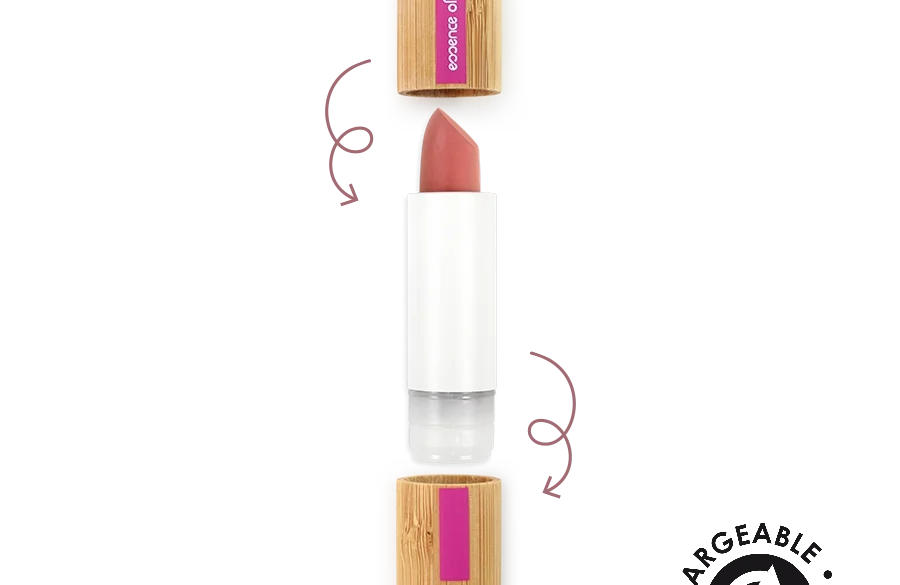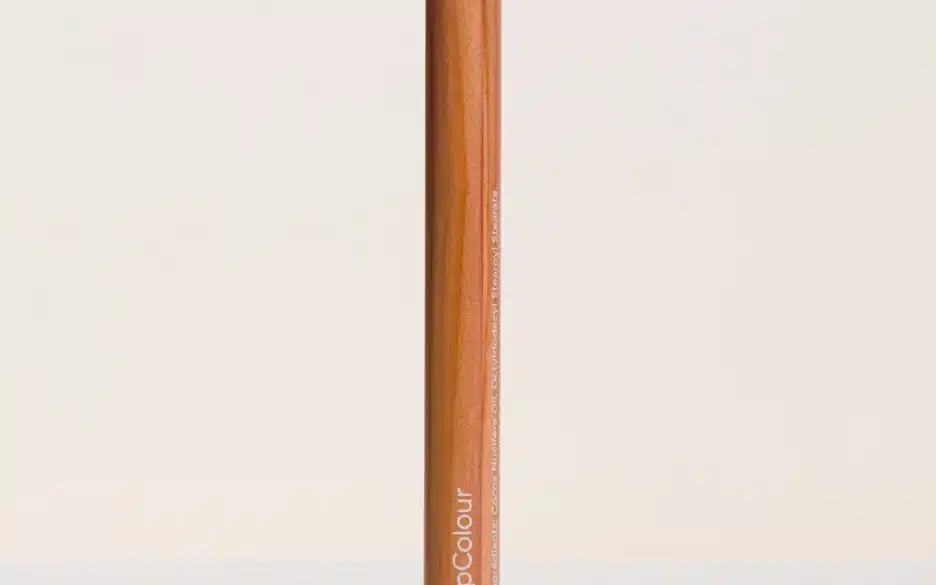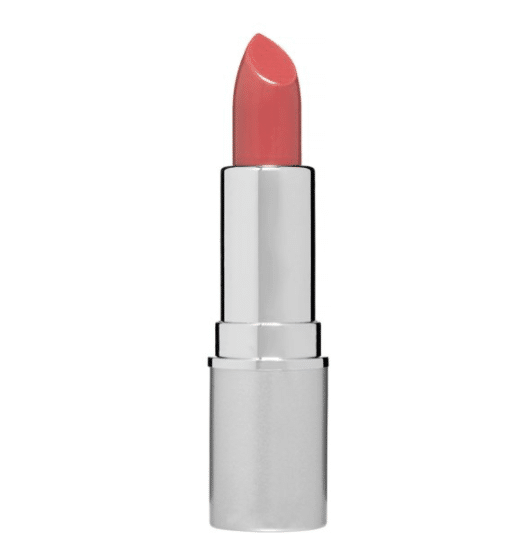If you’ve ever read the tiny print on the side of lipstick packaging, and you don’t have a chemistry degree, you’ve probably felt your eyes glaze over at the list of chemicals. Are these ingredients safe and eco-friendly, or downright toxic to you and the environment? As always, it’s a mixed bag for conventional cosmetics.
These days, I’m far more likely to pout about greenwashing in the cosmetics industry than to use lipstick to create the perfect pout. Researching this topic does have me excited about lipstick again though. That’s because there are some gorgeous, truly non-toxic, natural lipsticks available from super sustainable, eco-friendly companies.
You can read about our unique research process here. Then, replace your classic red lippy or a daring purple with a safe, non-toxic lipstick that can last all day without smudging, bleeding, or fading.
Before we get to the top picks, here are some common chemicals you’ll want to avoid in lipstick.
What to watch out for
Most conventional lipsticks contain petroleum-derived chemicals, potentially toxic FD&C and lake dyes, synthetic ‘fragrance’ and preservatives, and other ingredients that may have adverse health effects. Indeed, the US Food and Drug Administration bans certain ingredients from use in lip products because of the increased risk of ingestion compared to, say, an eyeshadow or blush.
As always, you’ll want to avoid the following:
- Parabens
- Phthalates
- Mineral oils
- Synthetic fragrances
- Synthetic preservatives
Look for natural preservatives in lipstick, such as vitamin E, beeswax, citric acid, and potassium sorbate.
Here are some of the other chemicals to watch out for in lipsticks and how to spot them.
Talc
Similar in composition to asbestos, and a known carcinogen, talc is often used as a base in cosmetics. Companies like Ecco Bella have replaced talc with a mixture of natural clays and minerals, cornstarch, and flower wax-coated pigments.
FD&C and D&C colors
Derived from bituminous coal (coal tar), these colors can be carcinogenic and are tested on animals. Some are more toxic than others, so if you’re going to choose a lipstick containing these, check every color number with the Environmental Working Group first.
Propanediol
Propanediol is found in many lipsticks and may cause irritation in some sensitive folks but isn’t toxic to humans or the environment. So, avoid if you’re concerned you’re sensitive to this chemical, but don’t worry too much otherwise.
Pentylene glycol
Pentylene glycol is a synthetic, low molecular weight solvent and skin-conditioning agent. It hasn’t been associated with any adverse health effects in humans, but very little study has been done on this ingredient.
Sucrose acetate isobutyrate
This chemical has been linked to liver toxicity in rats, but a human study found no ill effects when volunteers ingested 20 mg per kg of body weight per day for two weeks. A 2016 review by the European Food Safety Agency (EFSA) concluded that oral absorption is approximately 70% in rats, about 50% in dogs and ≥ 88% in humans, and that SAIB as used as a food additive (or, presumably, in similar levels in cosmetics) is not a safety concern. All in all, I’d avoid this chemical where possible but not worry all that much about very minor exposure.
Titanium dioxide
This is a naturally occurring mineral found in the Earth’s crust. It is white, opaque, and can refract light and filter ultraviolet light, making it a popular ingredient in lipsticks. I’d avoid pressed powders that contain titanium dioxide as it is potentially carcinogenic when inhaled. In lipsticks, though, it does not appear to present a health hazard. Avoid formulation with nanoparticle titanium dioxide, however, as these may increase the risk of health effects.
Other considerations
Some lipsticks shimmer, and that shimmer is often due to mica. While not necessarily toxic in itself, the extraction of mica, a shimmery substance, is linked to:
As you’ll see below, I favor companies with a transparent policy on ethical sourcing of mica. Where information isn’t readily available, I contact companies to ask about their stance on mica. I strongly suggest more of us do this as it helps let makeup companies know we care.
Our top picks
- Non-toxic lipsticks that also work for cheeks and eyelids
- Smooth, buildable color in a wide range of shades
- PETA-certified vegan and cruelty-free
- Mostly certified organic ingredients
- Palm oil-free, gluten-free, soy-free, fragrance-free, and no nano particles
- Plastic-free, zero-waste
- Responsible sourcing
- Made in the U.S.
- Award-winning sustainability champion
Axiology is a woman-of-color-owned small business offering innovative 3-in-1 sustainable Balmies crayons and Multi-Sticks. Instead of traditional plastic tubes, these crayons have a recycled paper wrapper. They come in a recyclable carrying case handmade from recycled trash by a women’s cooperative in Bali. The company’s zero waste and plastic-free packaging won it a 2020 Beacon Award for Sustainability Champion.
Around 70% of Axiology ingredients are organic, and the company sources its shea butter and moringa oil through fair trade channels.
There is some mica in the Balmies. Axiology sources this responsibly, avoiding pigments from mines in India or South Africa (where child labor and indentured labor are more common). The Balmies also contain biodegradable shimmer/glitter (made with seaweed) rather than plastic glitter.
Don’t be surprised by the size of the crayons! These Balmies are actually a fairly standard size for lipstick (0.12 ounces) but appear minuscule because they’re not sheathed and capped in chunky plastic.
Treat yourself to the bumper pack including all of Axiology’s crayons. Then add a single carry case (made with cardboard) for just $2 and stash your favorite color in your bag when you’re heading out.
- Moisturizing, layerable lip stain
- Vegan and cruelty-free
- Zero-waste, plastic-free
- Fully biodegradable tube
- Multi-use formula that works on lips and cheeks
- Certified organic ingredients: 90% organic content
- Made in small batches for freshness
- Fragrance/scent-free
- Deeper color options
- More color options
- Packaging can take some getting used to
River Organics offers two lip stain options – Fig and Pomegranate – with a third – hot pink Guava! – coming soon.
The River Organics lip stains are especially good options if you have dry lips or find that conventional lipsticks dry out your lips.
These lip stains use mineral-based pigments for clean, safe color without synthetic dyes. The multi-use formula can also work on cheeks and even eyelids.
- Certified vegan and cruelty-free
- Uses 45% certified organic ingredients
- 100% natural ingredients
- Very hydrating
- Comes in a refillable, more conventional type tube
- Zero-waste, smart packaging
- Good range of shades
- No nanoparticles
- A bit more expensive than other options
- Refills are made with (recyclable) plastic and aluminum
- Zao recycling facilities are only available in Europe, so far
Zao Makeup offers a nice range of lipstick shades in an easier to use, more conventional lipstick tube. This tube is endlessly refillable, though the refills come in a plastic and aluminum tube that can be hard to recycle in most places in the U.S.
In France, where Zao originates, retailers offer an EcoBox returns system where customers drop off used refills and other Zao products. These are pre-sorted and sent back to Zao for recycling. So, for European customers, Zao is a top option. For North America, I’ve pruned a leaf as it’s less eco-friendly than the brands above.
- Zero-waste, non-toxic, and vegan
- Moisturizing lip liner you can also use as lipstick
- Hardwearing
- Lids available to protect the pencil
- Not as quick to use as regular lipstick
- Requires sharpening
Elate Beauty doesn’t offer a conventional lipstick but the company’s lip pencil works great as both a lip liner and a lipstick, if you color between the lines.
The lip pencil is available in seven shades, including a vibrant red (Prim). It goes on easily and is moisturizing, so it doesn’t drag across your lips like some lip pencils can.
The only reason I’ve pruned a leaf for this one is because it isn’t as quick to apply as a regular lipstick. You’ll also need to sharpen it, unlike conventional lipsticks.
- Great coverage and moisturizing properties
- Long-lasting color and smooth feel
- Affordable
- Made with mostly organic ingredients
- Ethically sourced mica
- Third-party tested for heavy metals
- Free of nanosized particles
- 100% gluten-free
- Some shades contain suspected environmental toxins
Honeybee Gardens is often a top Leaf Score pick for eco-friendly cosmetics as the company offers quality cosmetics that are eco-friendly and non-toxic to humans. The lipstick collection is no exception. These products offer the coverage of a lipstick with all the moisturizing benefits of a lip balm. They go on smooth, provide long-lasting color, and are more affordable than most competitors.
Honeybee Gardens lipsticks are made with certified organic ingredients such as sunflower seed oil, cocoa butter, and sesame oil, as well as vitamin E.
I do have one caveat, though.
You’ll want to be careful which shade you choose.
Honeybee Gardens sources its mica as ethically as possible, usually from the U.S., in partnership with the National Resources Stewardship Council (NRSC). It also sends out batch samples regularly for third-party testing to ensure products are free from heavy metal contaminants and other contaminants.
Most Honeybee Gardens products are made in the USA, in Pennsylvania and California, but some are made in Canada, Germany, or Italy. None of the products are tested on animals and all have been reviewed by the Campaign for Safe Cosmetics, with a score of 2 or lower.
Honeybee Gardens reuses and recycles as much as possible. This includes using recyclable and recycled packaging to pad orders during transit.
Final thoughts: Is that lipstick vegan?
There are also several ingredients that pop up in lipsticks that aren’t typically detrimental to human health but aren’t vegan. These include:
- Cochineal – from crushed insects
- Pearl and guanine – made from fish scales and skin
- Carmine – from crushed bugs
- Beeswax (cera alba) – harvesting can compromise hive health





Hi, this is very helpful indeed. I was looking for a good lipstick for myself as I have sensitive skin. I loved the way you have described it. Got another article on similar line here -. Thank you guys for sharing.